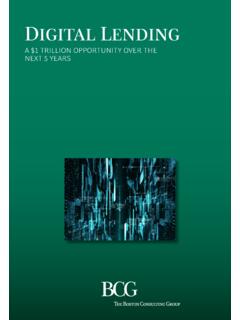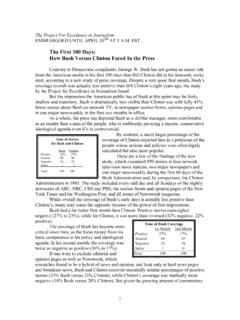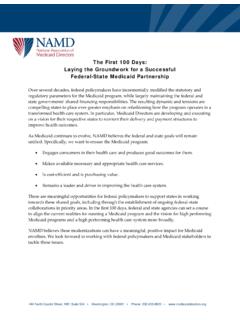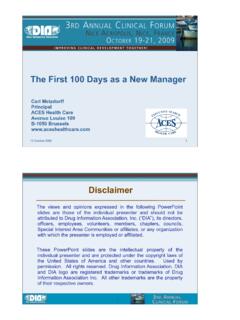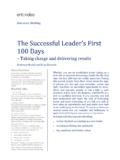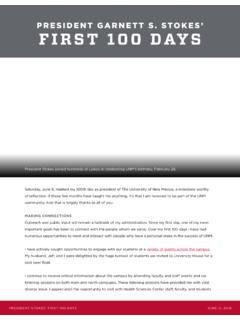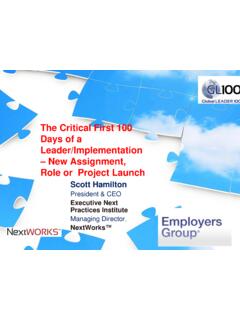Transcription of Debunking the Myths of the First 100 Days - image-src.bcg.com
1 Debunking the Myths of the First 100 DaysThe Right Way and the Wrong Way for New CEOs to Approach Their RoleThe Boston Consulting Group (BCG) is a global management consulting firm and the world s leading advisor on business strategy. We partner with clients from the private, public, and not-for-profit sectors in all regions to identify their highest-value opportunities, address their most critical challenges, and transform their enterprises. Our customized approach combines deep in sight into the dynamics of companies and markets with close collaboration at all levels of the client organization. This ensures that our clients achieve sustainable compet itive advantage, build more capable organizations, and secure lasting results. Founded in 1963, BCG is a private company with 78 offices in 43 countries. For more information, please visit BCG Game-Changing ProgramWe are living in an age of accelerating change.
2 The old ways are rapidly becoming outdated, obsolete. New opportunities are opening up. It is clear that the game is changing. At BCG, we are optimistic: we think that the fundamental drivers of growth are stronger than they have ever been in human history. But to capitalize on this trend, leaders need to be proactive, to challenge the status quo, to make bold moves: they need to change the game, too. The decisions they make now, and over the next ten years, will have an extraordinary and enduring impact on their own fortunes as well as those of their organizations, the global economy, and society at large. To help leaders, and to mark our fiftieth anniversary, BCG is pulling together the best ideas, insights, and ways to win to own the future. This report is part of that the Myths of the First 100 DaysThe Right Way and the Wrong Way for New CEOs to Approach Their RoleRoselinde Torres and Peter TollmanJanuary 2013 Debunking the Myths of the First 100 Days2 Large companies acquire a new leader every six or seven years, on average.
3 As the new CEOs settle in, they can apply conventional wisdom to make their mark. Many of the traditional guidelines are seriously misleading, Hundred days to Make an ImpressionDuring the 100-day grace period after taking office, new CEOs will study the com-pany s structure and contextual dynamics, and develop a plan of action that could set the tone for their entire tenure. They had better get it right. Myths Versus Realities as the Basis for a 100-Day PlanWe have identified five pairs of opposed principles that underlie and differentiate good and bad 100-day plans. The five misguided principles, or Myths , will tend to lead newcomer CEOs astray by encouraging rash interventions, for instance, or overattention to detail. The five counterpart realities will enable new CEOs to boost organizational performance by emphasizing teamwork, for instance, and by fine-tuning their dealings with the various stakeholders.
4 In that way, they can make a long-lasting imprint, rather than just an early A GLANCEThe Boston Consulting Group3It s tough at the top, and getting tougher. CEOs today have to operate in an unprecedentedly intricate and intense business environment, and newly installed CEOs are particularly hard-pressed. At any one time, 14 to 15 percent of CEOs are in their First year of office, and they face a challenging New-Look 100-Day Plan for a New CEO Confronted not just by the novelties but also by the ambiguities of the role they are stepping into, newly installed CEOs will respond in diverse ways. Some will view their debut as a balancing act. Others, undaunted, will view it as an impetus for bold, disruptive tradition, they will enjoy a 100-day honeymoon after taking office a time of being feted (often by an initial fanfare of optimistic press coverage) and indulged, perhaps, but also of being tested.
5 During this grace period, they are expected both to orient themselves and to make a favorable impression and instill confidence among internal and external stakeholders. They will use the time to identify the challenges, determine their key objectives, and draft a timetable. Ideally, they will also take the opportunity to convey their values and define their leadership style so that staff and stakeholders know what to expect. To facilitate all of this, they will need to devise preferably before the starting date an appropriate 100-day particular danger for new CEOs is basing their 100-day plan on a set of general best practices without taking sufficient account of the contextual fact base the specifics of the new job, the culture of the company, today s complex and dynamic business environment, and their own leadership style. In our work with numerous new CEOs over the years, we ve encountered several plans of this kind and identi-fied five common misconceptions that underlie them.
6 These misconceptions we call them the five Myths of the First 100 days might have an appealing ring to them, but they risk destabilizing any CEO Myths and the RealitiesIf new CEOs could keep these Myths in mind and resist them, then the leadership transition would cope more easily with all the additional complexities. (See the sidebar The Complex Life of a Modern CEO. ) The following inventory of wrong and right approaches is distilled from our varied client work across industries and incorporates many case studies. For obvious reasons, the details of these cases have been changed and sometimes tradition, new CEOs will enjoy a 100-day honeymoon after taking office a time of being feted and indulged, per-haps, but also of being the Myths of the First 100 Days4 Myth 1: New CEOs should direct their attention outward, and study the old way of doing things, in preparation for deciding what to keep and what to modifyMany incoming leaders put all their initial energies into studying the company intensely and trying to identify what works and what doesn t.
7 It is from this ap-praisal that they will determine corrective measures and put their own stamp on the organization. Above all, understand the externals that seems to be the When a new CEO takes office, the switch of leadership generates both risks and opportunities. On the one hand, it can reinvigorate the compa-ny or at least keep the company up-to-date and eager. On the other hand, it can be disruptive in the wrong way, causing confusion, a loss of business momentum, and even organizational paralysis. Consider three of all, it s much more complicated being a CEO nowadays than it was in the past. In today s turbulent, global-ized, and high-tech business world, large organizations have acquired complexities unimaginable to earlier generations. (See Smart Rules: Six Ways to Get People to Solve Problems Without You, BCG article, October ) And the complexity of the CEO s role has soared in proportion.
8 The number of performance requirements for CEOs is about six times more than in 1955, the year when the Fortune 500 was created. Back then, CEOs were measured against 4 to 7 KPIs; now they are typically measured against 25 to 40. (See the exhibit Brave New World of Corporate Complexity. )Then, to complicate their lives further, current CEOs have to deal with falling engagement levels among employees. Key engagement indicators dropped by as much as 14 percent during the recent financial crisis, particularly among middle and senior managers. (See Creating a New Deal for Middle Managers: Empowering a Neglected but Critical Group, BCG White Paper, July 2010.) Among employees generally, job satisfaction plummeted from about 60 percent in 1990 to less than 43 percent in A CEO today will often be in charge of a far more skeptical and dispirited work-force, and will struggle to secure its backing for new , CEOs are under much closer scrutiny from a broad set of stake-holders, both internal and external: activist shareholders, board members, employees, regulators, lobbyists, nongovernmental organizations, consumers, and the media.
9 (See New Leadership Rules: Requirements for the Future, BCG article, May 2010.) With so much information transpar-ency in the digital age, all of these stakeholder groups are now able and eager to inspect and critique almost anything that a CEO is doing and saying. To a greater or lesser extent, they all shape perceptions of a company, affect its reputation, and influence its fortunes and all too often they have conflicting expecta-tions and agendas. Some CEOs are energized by this type of volatile atmosphere and welcome the challenge of working with varied ThE COMPLEx LIFE OF A MOdERN CEOThe Boston Consulting Group5watchword. Their leadership approach can tend more toward the reactive than the active: they take their lead from the status quo (often in order to oppose it) rather than from their own strengths. Keen to make their mark, they might be tempted to alter the company s previous direction more sharply than is case in point: A newly installed CEO at an ailing industrial-goods company spent most of his settling-in time investigating and disparaging the work of his predeces-stakeholders.
10 For others it s a matter of dutiful acquiescence rather than enthusiasm, and they regard the edgy environment as an unavoidable reality that must be endured and deftly navigated. Either way, they often have to put enormous effort into the constant balancing of forces that they are obliged to This article, by Yves Morieux, appeared First in Harvard Business Review, September Things seem to be improving. The figure for 2011 was back above 47 percent. For all the figures, see Rebecca Ray and Thomas Rizzacasa, Job Satisfaction: 2012 Edition, The Conference Board, 2012. A brief summary can be found at back in time to 1955, when the Fortune 500 list First appeared, and you will find that most large corporations were relatively simple to operate by today s standards. Since then, the business environment has been transformed by developments in technology and globalization, as well as by intensified competition.







